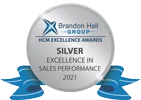How to Leverage Your CRM for More Accurate Sales Forecasts

Recent years have shown a skyrocketing adoption rate of different CRM solutions. In 2015, 91% of domestic companies with 11 or more employees relied on a CRM to manage their customers, opportunities, and any other tasks related to sales and customer service. Across the business landscape, there is no slowdown in organizations wanting to adopt a CRM—currently, the CRM industry is expected to grow from where it was in 2014, when it was a $24 billion dollar undertaking, to where it will be by 2017, when it’s predicted to hit $37 billion.
Considering these statistics, it seems a bit surprising, that given the massive adoption rate of CRMs, there are still many companies that don’t fully leverage the tool to get the most out of it. More specifically, this is driven from organizations failing to use their CRMs’ reporting capabilities to their full potential and to interpret data that can help drive smarter business decisions.
In terms of reporting, a common pain point in particular is forecasting. Below are some pointers for maximizing the effectiveness of your CRM as a tool for more accurate sales forecasting.
The Implementation Phase
In terms of baseline contribution, a CRM should function as a productivity tool that provides sales organizations with a way of managing and analyzing customer data, and to keep track of everything else that is relevant to the relationship between buyer and seller. In an ideal scenario, the CRM should increase team productivity and create company-wide accountability. In order to meet these objectives, the right CRM implementation strategy is key:
- Outline your objectives and sales process, and then work backwards from there. Your CRM can be an effective tool for your sales force that should support how you work, not dictate the work itself.
- Don’t do complexity for complexity’s sake. As you set up your CRM to work for you and your team, focus on simplicity, particularly during the early stages. Too often organizations will turn on all their CRM’s bells and whistles, only to realize they don’t need that level of complexity—and the confusion that comes with it. Again, keep it simple. You can always expand later.
- A crowded interface is not your friend—when too much is vying for your attention on the screen, it’s easy to feel overwhelmed and hard to focus. Once you’ve identified what you need from your CRM, remove fields that aren’t applicable to how your organization works. Less is more in this case, and streamlining the user interface will help your team focus on the data sets that are most meaningful and impactful.
- Keep things easy for your reps by automating steps and workflows within your CRM. Use plug-ins to sync email correspondence with the reciprocal CRM contact record. Most third-party productivity apps such as marketing automation tools or lead generation tools also provide connectors to sync any relevant data with the corresponding CRM record.
Define Your Sales Processes
Determine and communicate benchmarks, or stages, in the sales process that each member of your team understands. Each stage should have check points that the sales manager can evaluate and discuss with their team and, as a result, confirm that the appropriate stage, or milestone, has been selected during each sales process. For example, in order to mark an opportunity as having reached the “Demo,” or “Presentation” stage, a lot of discovery activities must have taken place, such as calls, emails, notes, etc.—all of which ideally should have been logged in the CRM, making it a snap for the sales manager to confirm that the discovery phase has indeed been completed by the rep.
Honesty Is Key
Every sales organization has members who run around just on the verge of that next huge deal that’s about to close any day now. Red flags like inflated opportunity amounts, opportunity cycles that remain open for far longer than the company average, or mismarked opportunity stages all indicate data that’s been distorted to create a picture of success during weekly sales meetings. In other words, someone is putting on a good show that’s going to close on opening night. In reality, the rep is diluting the data that’s going into the sales manager’s forecast. Stressing the importance of realistic opportunity data with your reps will make for better, more accurate forecasts. Create an atmosphere of honesty, where reps are reporting the actual status of their sales, without fear of repercussions for being the messenger of bad news. Put them at ease that no one’s going to get in trouble because a “sure-fire great deal” has been gathering dust in the pipeline.
Finally, give your sales reps a feeling of ownership in the process by keeping them up to speed on your sales forecasting goals and overall progress during your weekly check-ins with them. Celebrate the contributions of individuals and bask together in their wins. This will create an even deeper sense of teamwork and how each and every reps is important to making the big picture something everyone will enjoy looking at.

- Account Planning (12)
- Awards (44)
- Client Testimonial (37)
- Personal Branding (21)
- Podcast (12)
- Research (78)
- Sales Career Development (90)
- Sales Coaching (166)
- Sales Consulting (141)
- Sales Culture (180)
- Sales Enablement (382)
- Sales Leadership (116)
- Sales Management (267)
- Sales Negotiation (14)
- Sales Prospecting (138)
- Sales Role-Playing (19)
- Sales Training (243)
- Selling Strategies (281)
- Soft Skills (78)
- Talent Management (101)
- Trusted Advisor (29)
- Virtual Selling (57)
- Webinar (13)






















